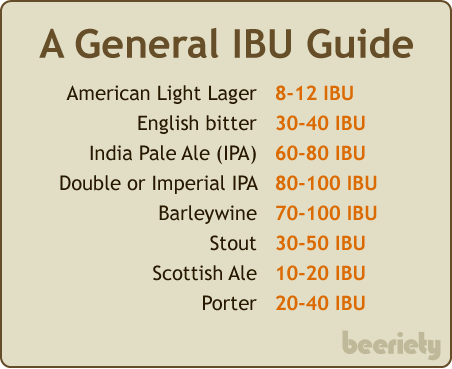5 Abbreviations Brewers Use that Everyday Beer Drinkers Should Know
If you have virtually any education, you know there’s a lot of abbreviations that go into science (just take a look at the periodic table). And the science of brewing beer is no exception. In fact, if you’ve ever read a craft beer label or review, there’s a good chance you’ve seen a bunch of these abbreviations—ABV, SRM, IBU, and more.
Beer drinkers in the know can translate these abbreviations and their corresponding numerical values into characteristics such as a beer’s strength, color, or bitterness. So you don’t find yourself scratching your head next time you see “85 IBUs” on an imperial IPA bottle, we put together a list of five abbreviations you’re likely to come across in your beer drinking journey.
1. ABV – Alcohol By Volume
Fans of highly alcoholic beers are well aware of what ABV means—or at least that a beer with an ABV above 10% has the potential to leave you with a buzz before the first pint’s finished. Determined with an instrument called a hydrometer, ABV is an indicator of how strong a beer is. But more specifically, it’s the portion of the entire volume of liquid that’s actually alcohol.
Dunerbrew shared an interesting chart last year that shows the typical ABV by style. The styles are based on the Beer Judge Certification Program (BJCP) Style Guidelines.
Interesting fact: The strongest beer in the world is the Scottish Brewmeister Armageddon. Straight from the brewer: “Despite being 65%, the beer has a lot of flavor-malty, hoppy, slightly sweet and lots of yeast still in the beer. Be careful, though, smelling it is probably enough to put you over the limit!”
2. ABW – Alcohol by Weight
If you’re one of those people who always checks the ABV, in your beer-drinking travels you may have come across something that says “ABW.” This isn’t a typo—rather, it means “Alcohol by Weight,” which is just another method for determining the beer’s alcoholic content. Be careful when you see this, though, because ABV and ABW have different variables in their calculation, and so the alcoholic content of the same beer is communicated with two different numbers.
Math time: To convert ABW into ABV, just multiply the ABW by 1.25. Quick example: ABW of 10% would equal ABV of 12.5% (10% x 1.25).
 3. IBU – International Bitterness Units
3. IBU – International Bitterness Units
Any hopheads reading this? Just like it sounds, IBU is a measurement of a beer’s bitterness, which comes from the hops used during the brewing process. It’s measured through the use of a spectrophotometer and solvent extraction. You’ve probably heard some beer geeks talk about the 80 IBU cutoff point. This is basically just a point on the IBU scale where things start getting noticeably bitter—think double IPAs and barleywines.
Beeriety shared a pretty simple guide to understand IBUs, but these can get much more complex. For anyone interested, here’s a complete breakdown from Home Brew Manual of beer styles by IBUs.
Who’s the leader? With a whopping 2,500 IBUs (there’s not an extra zero in there), Canada’s Flying Monkeys Alpha Fornication is the bitterest beer ever brewed.
4. SRM – Standard Reference Method
SRM refers to a system used to specify beer color intensity. That’s right, there’s a beautiful rainbow of beer colors that each have a numerical value, from Pilsner (2, very light) through Imperial Stout (40+, very dark). Adopted by the American Society of Brewing Chemists in 1951, SRM is determined by measuring the absorptivity of a wavelength of 430 nanometers passing through one centimeter of beer.
The chart below from Two Beer Dudes displays both beer colors and SRM value and beer style SRM color ranges.
Bonus points: SRM’s calculation is a bit complex, but if you see a girl wearing a t-shirt that says “SRM = 12.7 x D x A430” you might want to get her number.
5. OG/FG- Original Gravity/Final Gravity
When it comes to beer or other alcoholic beverages, gravity (referred to by brewers as specific gravity) has to do with the relative density of the wort at various stages of the fermentation process. OG refers to the specific gravity of the unfermented wort. FG—on the other hand—refers to the specific gravity of the fermented beer. In between OG and FG, some of the sugar in the wort is fermented into alcohol, while the remainder becomes part of the beer’s body (its taste).
Some trivia for you: FG is always lower than OG. Because sugars are converted into both alcohol and carbon dioxide during the fermentation process, the specific gravity reduces. Some sugar is gone, and then alcohol is naturally less dense than water.
Continuing On the Path Toward Beer Geekdom
One of the most interesting parts about drinking beer is that there's so much to learn. And as your knowledge of what goes into making beer or your ability to understand the characteristics of beer increases over time, it will really only give you a better experience. Trust us, if you continue educating yourself, you'll appreciate a good brew even more than you do now.
Love beer or know a beer lover? Check out our new merch for the holiday season.

